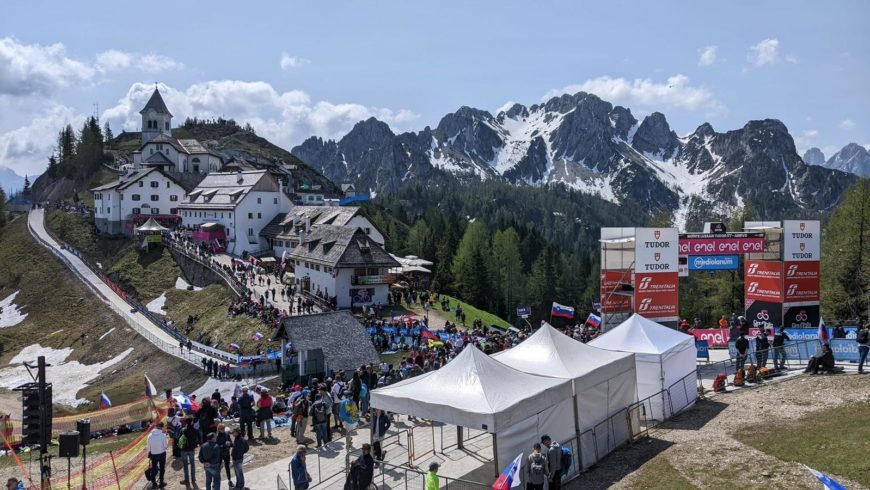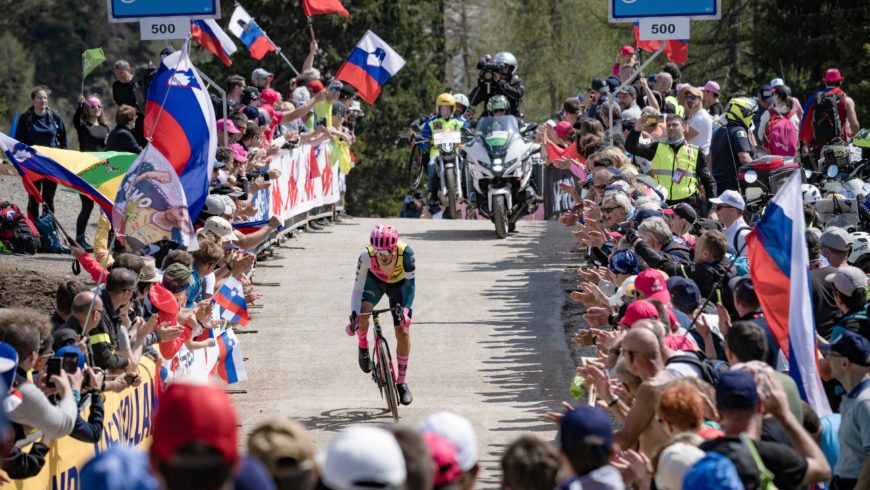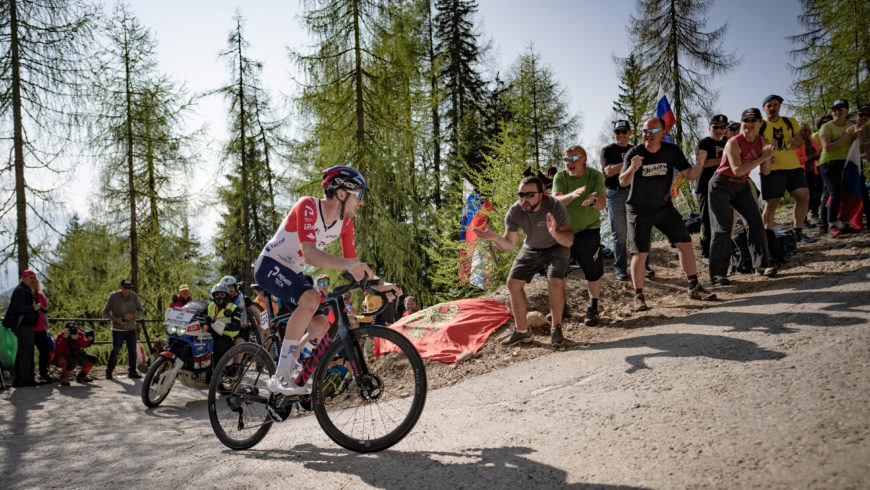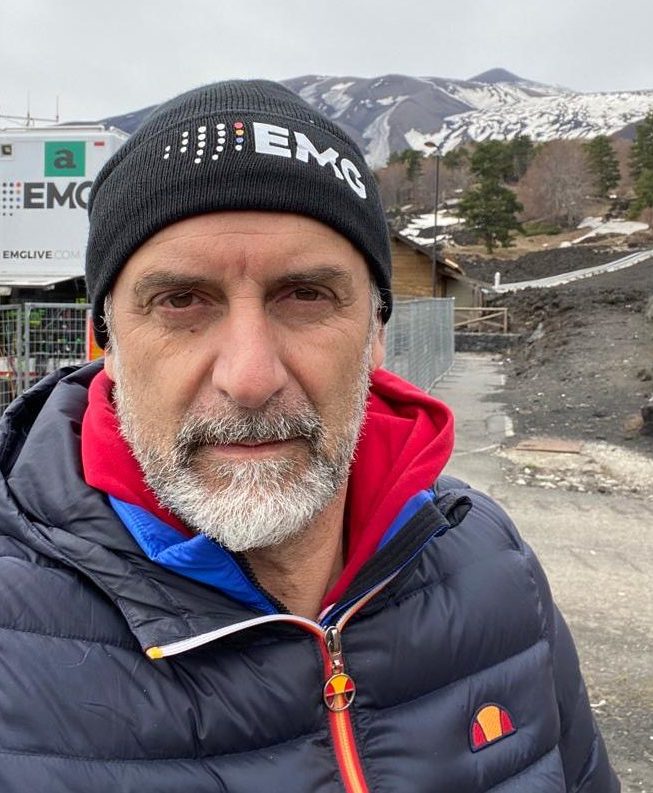EMG Italy
- EMG Global
EMG Countries
- EMG Belgium
- EMG France
- EMG Germany
- EMG Netherlands
- EMG USA
- EMG United Kingdom
EMG Brands

The penultimate day of the 2023 edition of the very famous Giro d'Italia saw the cyclists engaged in a special stage, the Tarvisio-Lussari, for an uphill time trial, unique in terms of type of route and importance in awarding the title .
Davide Furlan Outdoor Production Director of EMG Italy says:
“The 2023 Giro turned out to be more demanding than expected for all the participants, for the athletes who still had to deal with Covid which forced them to withdraw (like the Belgian Evenepoel) and for the RCS organizer who had to come to terms with these withdrawals and with the numerous controversies exposed by the media for the choice of paths (too hard according to some).
Challenging also for the injured athletes due to the numerous falls, due to the slippery asphalt due to the constant rain and - consequently - also demanding for our television production which, due to the adverse weather, had to manage the daily set-ups of the stages in extreme conditions. It must be said that the experience gained by the technical team present has reacted to these difficulties in an impeccable manner and the preparation for the event in recent months allowed for perfect and punctual production".

Very specials of the 2023 edition
This year the Giro has decidedly unique specificities rarely encountered for TV production in World Tour races: for example, 9 stages which, due to their length, exceed the flight autonomy of the radio link plane. This forced the production to use a second twin aircraft, essential to maintain the continuity of the live transmission of all the radio signals of the 10 motorcycles and 2 helicopters.
Another unique feature of this year was the special stage on the penultimate day of the Giro, the Tarvisio-Lussari uphill time trial. This portion of the Giro required a truly unique organizational and productive effort for everyone, obviously combined with the sporting effort of the athletes engaged along the ascent to the Sanctuary.
In this stage, all of EMG's experience was brought into play: it was a question of producing a time trial and uphill cycling race, the time trial thrives on specificities linked to the presence of intermediate points for recording the times, in these precise points the timing photocells and a video camera that records the moment of passage must be positioned. This workflow is quite simple to manage when positioning takes place in places where it is possible to park an SNG satellite unit and where a stable internet data connection is available. In the Lussari stage, on the other hand, this aspect was decidedly more complicated, due to an impervious 8km mountain path just 3m wide, in the middle of a dense forest totally devoid of 4G coverage, and where it was known that it would not have been possible to use of Ka-Sat technologies.
Added to this is the further complexity of the fact that all of EMG's TV Compound for international production was positioned downstream of Mount Lussari at 700m above sea level, while the arrival of the stage was positioned at the top of 1700m above sea level, and all the techniques were connected in fiber at a distance of 6.5 km.
A unique set-up, in the woods
“The envisaged set-up”, resumes Furlan, was the result of a mix of experiences acquired over the years from numerous productions of the Ski World Cup, the Olympics and the Winter Universiade. These extreme situations allowed us to think of a very similar technical set-up, in terms of distances and environment, and a system of fixed cameras connected through the use of dark fibres. To these were added three stations with SNG for the intermediate timing points, and an internet network was generated nearby thanks to the installation of some repeater links on the adjacent mountain, with an up-down capacity of synchronous 60-70Mbit .

The network was used to send back-up images, to connect the timing network with the server at the TV compound and, last but not least, to generate a technical coordination call on the cloud between the Master gallery and remote SNG stations.
The fundamental communications for the camera operators and for all the technicians in these remote positions in the woods were guaranteed by the aerial link which radiated the frequency of the "Ordini Regia" channel in the valley, and by a double circuit UHF bridge installed on the stand alone via fiber at an altitude of 1700mt. The technical system for communications, especially in these conditions, is a fundamental piece for the entire production, and also in this stage the work done by the EMG team was perfect and reliable as required".
Last kilometers
Along the last 2km of the route (normally in the stages of the Giro only the last km is covered), the following were positioned: a camera on Jimmi-jib at 1.7km, a camera on a drone to cover
a 300m piece of forest that couldn’t be scrutinized from the helicopter, due to the thick vegetation, numerous cameras, including ground and shoulder cameras, in an interview position and podium with all the necessary audio and intercom services. The stage had truly impressive television coverage, EMG supported the event with 29 cameras connected via RF, via satellite, via 4G and via fiber, 5 EVS Xt3 plus two Avids to complete the impressive production plant.
This setup put every element of the production to the hardest test with obvious technical stress due to the high number of connected "elements", in a very difficult environment and with very tight set-up and test times. To this were added obvious editorial stresses to be able to tell a truly unique race of its kind, which was the epilogue of the entire Giro d'Italia 2023.

The "uphill" comment
“All of this” concludes Furlan, “was only possible thanks to the experience gained in many “extreme” productions made over the years by the EMG teams.
That's why RCS has chosen to have us by its side as co-producers and not just as technical service for their important tenders.


Throughout the Giro, the EMG production unit was the Orion 209, while the Nova 126 unit was used for this special stage. This change made it possible to carry out the complicated set-up during the three days preceding the stage with a second dedicated crew. In these days the Orion 209 continued to flawlessly cover the other stages of the Giro along the roads of the Dolomites and then, together with its crew, was transferred from the three peaks of Lavaredo to Rome for the last stage and the grand finale with the finish line at the Imperial Forums, a worthy epilogue and a fair closing "walkway" for a truly prepared and professional team that was able to react even against the adverse weather conditions of this year. My many thanks go to each one of them for the result achieved, it was a great race, a great Giro”.
Logistics
Valentina D'Alia, who coordinates the Booking Department of EMG Italy for the Giro, also with Salvatore Amato and Nicolò Selvestrel, took care of all the logistics of the Giro caravan, i.e. all the reservations for the hotels, those of the 10 cars and 8 vans for travelling, the two mobile office campers located at the finish line, three vans for transporting goods. In addition, the department coordinated personnel transfers by train, administrative management of personnel, tracking of collaborator costs, packed lunches for motorcyclists, and much more.
There were four teams to manage and three workstations for all 29 days of the Giro, i.e. start, finish and intermediate positions.
For the approximately 100 people involved (120 in some stages such as Tarvisio), it took care of the reservations of the transport vehicles of the Italian and foreign crews, for the Belgians and French, and of the overnight stays for a total of 173 hotels or accommodation facilities booked and 1,898 rooms.
“Some stages", says Valentina, "like that of Tarvisio were particularly difficult not only for the uphill runners, but also for us given the scarcity of accommodation facilities - saturated or closed due to the off-season - which forced us to find accommodations in Slovenia”.
©2023 EMG Italy – Presspool PressOffice RobertoLandini
Do you have questions or need information? Fill in your contact details and we'll contact you as soon as possible!
"*" indicates required fields